Ankle Arthrodesis in the Treatment of Neglected Ankle Fractures ()
1. Introduction
Post-traumatic osteoarthritis is by far the greatest contributor to osteoarthritis of the ankle due to the fact that ankle fractures represent by far the most frequent etiology due to the prevalence of these lesions which occupy the third rank of limb trauma after fractures of the lower extremity of the radius and those of the upper extremity of the femur [1]. There are many therapeutic possibilities, ranging from purely symptomatic conservative treatment to surgical treatment, namely arthrodesis of the ankle or, in recent years, the placement of a total prosthesis. The term arthrodesis was first described in 1879 by Australian surgeon Eduard Albert [2]. Ankle arthrodesis has become the gold standard surgical intervention for the terminally ill ankle [3] [4]. There is a wide range of surgical approaches for this procedure. Méary used an anterior approach to the ankle with fixation using two screws [5]. The goal of surgery is to create a painless, stable, and plantigrade ankle. The foot and ankle must be properly aligned in the optimal position for proper locomotion [6]. Neglected ankle fractures are common in our regions. Patients first consult traditional healers and it is when the signs persist that they consult the surgeon for a swollen and painful ankle. Initially we always performed anatomical repairs with osteosynthesis, but the majority of patients still complained of pain and disability. We wondered whether a primary arthrodesis would not be indicated in old ankle fractures to avoid disabling pain for patients. We therefore performed a series of arthrodesis on neglected post-traumatic ankles. The objective of our study was to describe the results of arthrodesis on an old post-traumatic ankle and to propose a therapeutic indication in the face of any neglected ankle fracture.
2. Material and Method
This was a prospective study over 8 years between December 2012 and November 2020, involving 36 cases of neglected ankle fractures treated by arthrodesis (Table 1). We included in this study all patients with an untreated ankle fracture older than 45 days (Picture 1). All patients whose fracture was not displaced and did not require correction were not included in the study. We used Meary’s technique in all patients. An anterior approach to the ankle was performed (Picture 2). The foot was fixed in the horizontal plane between 0 and 5˚, in the frontal plane between 0 and 5˚ of hindfoot valgus and in the sagittal plane at 90˚ of dorsal flexion. Fixation was achieved by two large fragment screws crossed in the three planes of space. Postoperative immobilization was ensured by a splint and then a cast boot maintained for three months. Rehabilitation was started as soon as the plaster was removed and it mainly targeted the joints of the forefoot. The AP and lateral X-rays made it possible to assess the consolidation by the appearance of trabecular bone bridges covering at least 50% of the tibiotalar space, as well as the alignment of the ankle. The postoperative evaluation was based on the clinical elements, in particular the stability of the ankle and also the presence or absence of pain. We assessed the degree of patient satisfaction (Table 2): satisfied, moderately satisfied or not satisfied. We used the AOFAS (American Orthopedic Foot and Ankle Score) [7] preoperatively and postoperatively for an objective assessment (Table 3).
![]()
Table 1. Etiological and evolutionary characteristics.
RA: road accident.
![]()
Table 2. Evaluation according to the degree of satisfaction.
![]()
Table 3. Patient assessment using the AOFAS.
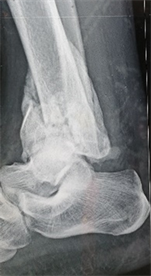 (a)
(a)  (b)
(b)
Picture 1. (a) profile view (b) front view, fracture of the tibial pilon and the external malleolus three months after the initial trauma.
3. Results
The mean follow-up follow-up was 4.2 years. We did not record any loss of sight. The average age of our patients was 43 years old, 28 were men and 8 were women. The average consultation time after the trauma was 5.2 months.
Reduction and fixation were satisfactory on all control radiographs (100%) (Picture 3). The fusion rate was 97.2%.
The two cases of infection observed were superficial. They were treated with local dressings and antibiogram-guided antibiotic therapy. Also cases of skin necrosis were treated by directed healing. The average time to fusion was 4.2 months (Picture 4).
There is a significant improvement in ankle function after arthrodesis in patients (P < 0.001).
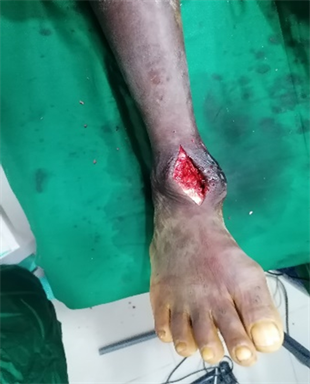
Picture 2. Anterior approach to the ankle.
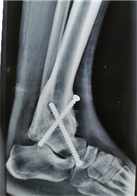 (a)
(a)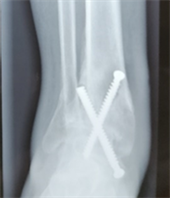 (b)
(b)
Picture 3. (a) profile view (b) front view, arthrodesis of the ankle according to the Meary technique, satisfactory joint fusion at 7 months postoperative.
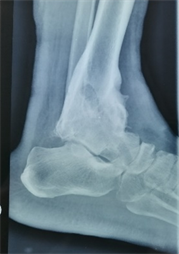 (a)
(a) 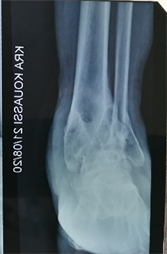 (b)
(b)
Picture 4. Screw removal at 18 months post-operative, (a) side view (b) front view, satisfactory joint fusion.
4. Discussion
Our study has some limitations such as the sample size which is not large enough. But it appears to be one of the rare studies that tries to solve the problem of therapeutic indication in old ankle fractures. These fractures represent a recurring problem in our regions. The majority of studies have focused on the treatment of primary or post-traumatic osteoarthritis [8] [9] [10]. Our patients were mostly young (38.2 years old) contrary to the average encountered in certain studies. difficult to take in front of this young age of our populations. But in view of the unsatisfactory results observed with osteosyntheses, this indication tended to prevail. Patients came to us late. According to beliefs, they preferred to consult traditional healers first. They carried out inopportune massages and tractions of the ankle, often causing periarticular osteomas or algoneurodystrophy. It is most often in an array of trophic disorder that these patients consulted. Meary’s technique is the only one we used for all our patients (n = 36). It’s simple and requires less internal hardware, just two space-saving screws. The disadvantage lies in the anterior approach which presents a risk of neurovascular injury and skin necrosis. We recorded 3 cases of skin necrosis which were treated with local dressings. But we did not record any neurovascular lesion. Several techniques and approaches are proposed. The lateral approach seems to give a good light on the joint and present less risk of nerve and vascular injury. The use of the external fixator in arthrodesis was reserved for cases of joint sepsis. But this technique generated many cases of non-union before Chandley introduced joint compression [11]. Arthroscopic ankle fusion is gaining popularity due to its advantages such as reduced incision size to minimize morbidity, shorter hospital stay, shorter time to fusion with similar union rates or best [12] [13]. But this technique is good for cases with minimal or no deformity or bone loss, although some authors oppose it [14]. The fractures that we had to treat presented significant deformations, requiring a correction of the axis of the ankle. Authors compared the results of arthrodesis on primary osteoarthritis with those on
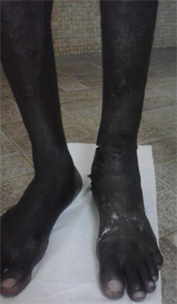 (a)
(a) (b)
(b)
Picture 5. Appearance of the foot after plaster removal (a) front view (b) side view, satisfactory positioning of the foot.
post-traumatic osteoarthritis [15]. They found the results of the former better than those of the latter. Usually the primary indication for ankle arthrodesis has been for persistent ankle joint pain and stiffness that is functionally disabling for the patient and is not alleviated by nonoperative treatment methods [16]. Our indications were not posed for declared osteoarthritis, but especially for traumatized ankles that were highly candidates for osteoarthritis. We obtained a very high satisfaction rate (94.44%) (Picture 5). Patients who had undergone osteosynthesis frequently reported disabling pain in which revision surgery for arthrodesis was performed. Smoking has been implicated as a factor in non-fusion after ankle arthrodesis [17]. The only case of non-union observed in our series was in a patient who was a heavy smoker. The young age of our population could be favorable to the high rate of fusion that we observed (97.2%). Our results showed a significant improvement in the condition of patients after arthrodesis (p < 0.01) after evaluation by AOFAS. Ankle arthrodesis could therefore be proposed as first-line therapy in the treatment of neglected ankle fractures with significant trophic disorders.
5. Conclusion
Arthrodesis of the ankle certainly condemns a joint so essential to the proper functioning of the lower limb during walking, but it allows the patient to be relieved of such costly suffering, especially pain. It appears here as an important alternative in the treatment of neglected ankle fractures with significant trophic disorders. The comparison with total ankle arthroplasty is still under discussion. But we believe that arthrodesis is a simple and effective therapeutic means.
Authors’ Contribution
All authors contributed to the writing of this manuscript and gave their approval to the final version.